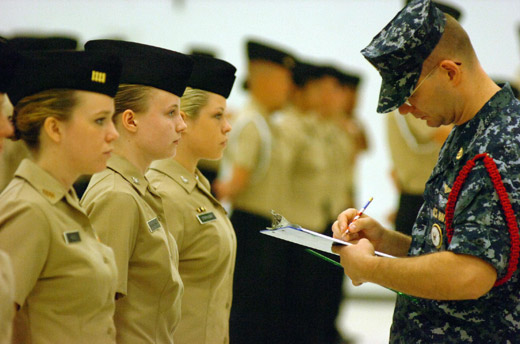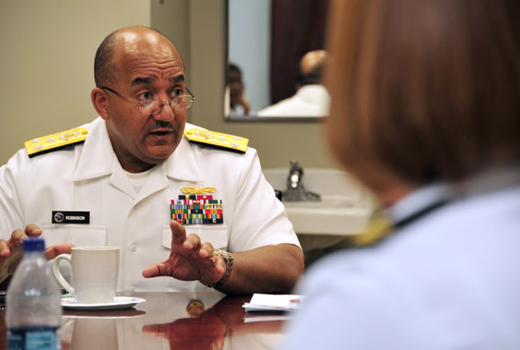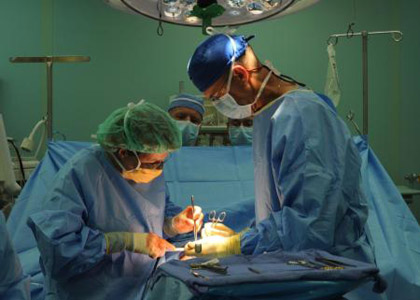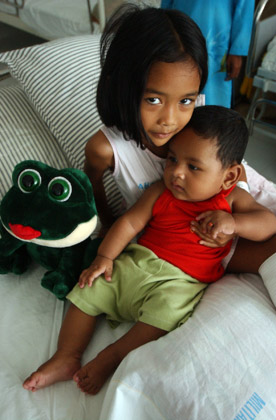Vice Admiral Adam Robinson: The Nation’s First Black Navy Surgeon General
The first black Surgeon General of the U.S. Navy, Vice Admiral Adam Robinson, continues a proud tradition and belief in the importance of education, which began with his grandfather, who was an 1898 Greek and Latin college graduate in Louisville, KY. To put the latter’s achievement into perspective, Lincoln’s Emancipation Proclamation had just been issued in 1863 and the black literacy rate was around 5 percent. By the time Robinson’s grandfather graduated college, the black literacy rate had risen to 40 percent, but only 6 percent of U.S. residents, regardless of color or ethnicity, had graduated high-school, much less college.
Robinson’s father, a 1932 graduate of Indiana University and a 1937 graduate of Howard University’s medical school, was an equally adamant proponent of education. The Navy Surgeon General, a 1972 graduate of Indiana University and 1976 graduate of the university’s medical school, remembers his father’s preaching on the importance of education.
“Education for me, from the time I was small and could remember even thinking, was a given. I was going to go to college because I was told I was going to college,” explains Robinson. “But this is key: I was going to go to college because at some point when I was little, I decided I was going to go to college. I didn’t care what anyone said. It was my decision.”
Life took one of its usual twists and turns when Robinson’s father died while he was still an undergraduate at Indiana. The Surgeon General was accepted to medical school, but he didn’t have a way to pay for it. He remembers: “I needed a stable source of income, and the Health Professionals Scholarship Program, of which I was in the first class in 1972, was just coming along. So, I joined it. Why the Navy? I think the best answer to that is John Kennedy. It was not only PT 109. I remember distinctly his assassination on November 22, 1963. When President Kennedy’s body was brought back to Washington, D.C., he came to Bethesda Naval Hospital. I said to myself, ‘My gosh, I have to see that. I want to know what that place is like,’ and it was imprinted on my mind. When I had a chance to get a Health Professionals Scholarship, I could have joined the Army, Navy or Air Force. But, for me it was simple; I’ll go Navy.”
Robinson is first generation military. No one in his family had served prior to him, so his decision to make the military a career was not a natural progression. It was primarily a product of his extensive medical education and experience.
The Surgeon General came into the Navy as a general medical officer. He did his residency in General Surgery at Bethesda, which was, according to Robinson, “very arduous.” Afterwards, he went to Japan as a ship surgeon on the USS Midway and then as a staff surgeon at Yokosuka. While there, things changed for him.
“I realized the people I was working with – nurses, Corpsmen, doctors, patients, the line, everyone – were the finest people I had ever been with. I couldn’t recreate this anywhere. I felt the quality of the medical education, the care and the Corpsmen, were the best. However, the most unique thing was that I could recreate this practice anywhere there was a Navy. If we were at sea on a ship, I had it. It was a little different, but I had it. If it was a Naval hospital in Spain, Italy, Japan, Okinawa or anyplace else, it was the same. The same quality and type of individuals were there,” he explains.
Robinson had a major decision to make by the mid-1980s in about his 10th or 11th year with the Navy. At this point he had finished his residency in general surgery, his fellowship in colon and rectal surgery, and two or three tours in the Navy. He remembers, “Now it was time to pack it up and join the Reserves, pack it up and go to the civilian side or stay. I decided to stay because I didn’t think I could duplicate the quality of work I was doing anywhere else.”
At that time, Robinson had no desire to do anything but surgery and patient care, which is what he did for the first two-thirds of his Navy career. He was totally involved with clinical surgery and teaching. Robinson was at Bethesda Naval Hospital as a staff and faculty member, and at Portsmouth Naval Hospital as Chief of the General Surgery Department and also Residency Director for General Surgery.
“That’s what I wanted to do; I wanted to be a professor of surgery. After I was there, I was tapped by other people to do more executive medicine roles,” explains Robinson. His first significant non-hospital executive medicine role was Surface Atlantic Fleet Surgeon, which the then Navy Surgeon General called him to do.
Robinson spent from 1977 until 1994 doing nothing but surgery and medicine. He had been around the world at multiple places, but, he explains, “I didn’t know what the Fleet and Navy were. I knew who I worked for – I wasn’t having an identity crisis. I could tell you about Navy hospitals, about anything Navy medical and about TriCare. But, I couldn’t tell you about the Surface Atlantic Fleet, and I couldn’t tell you what a Type Command was. And, I couldn’t tell you how Navy medicine hooked up to the line and how we, in fact, served the purpose of doing force health protection, which is the essence of Navy Medicine.”
After Surface Atlantic Fleet, Robinson became Executive Officer at Jacksonville Naval Hospital, where he had a chance to lead men and women at a large, family practice teaching hospital in Florida. In addition, he took the Fleet Hospital to Haiti for a six-month deployment. While there, they treated 27,000 Haitian nationals during their humanitarian assistance missions. Robinson left Jacksonville for Washington, D.C., where he was assigned to Health Affairs in the Department of Defense and also practiced part-time at Bethesda. His next stop was back to Yokosuka as Commanding Officer, after which he made Rear Admiral (lower half). Upon returning to Washington, D.C., he commanded the National Navy Medical Center at Bethesda Naval Hospital from 2004 to 2007. Although this was a disastrous time period for Walter Reed Army Medical Center regarding patient care and other issues, it created a unique learning environment for Robinson.
“I had an opportunity up close and personal to see how fragile the relationship is between our patients and our families, and the covenant relationship we have with them regarding how we care for people. The issues at Walter Reed were not care or quality of care issues, but non-medical case management issues, such as what sorts of facilities are people staying in, and are they up to par for our people. These were all things that we in the military have to be cognizant of, and we have to make sure we do right,” he explains.
Shortly thereafter, in 2007, then Chief of Naval Operations Admiral Mike Mullen selected Robinson to become Surgeon General. He was asked to extend for additional year by Mullen’s successor, Admiral Gary Roughead. After four years leading the global Navy medical team, Robinson plans to retire in November 2011.
Navy Medicine Education Opportunities
Robinson, like his father and grandfather before him, is a strong education advocate. He is passionate about encouraging young people to interact with the Navy League or to join the Sea Cadets, if available locally, like they do Boy Scouts, Girl Scouts and Cub Scouts.
“Those are wonderful ways to get an introduction to the Navy – to see what NROTC (Naval Reserve Officers Training Corps) and junior NROTC are about, and to find out what scholarships and educational opportunities are available. This includes the Naval Academy prep school, the Naval Academy itself, the Coast Guard Academy and the Maritime Merchant Marine Academy. All are great educational institutions that, upon graduation, offer excellent career opportunities,” explains Robinson.
He continues by saying that “many people don’t know about these mechanisms to get youth started. Opportunities exist in college for young people to join the military, to have their education paid for and to increase their sphere of life experiences around the world. They’ll often receive stipends and have a chance to train during off-academic times. And, it’s a way of learning service, culture and world traditions.”
Medical fellowships are also available, but only open to people in the military. Regarding the Navy in particular, it has, according to Robinson, a very vigorous graduate medical education program. The Navy has three medical centers – Portsmouth Naval Hospital, Balboa Naval Hospital in San Diego and the new Walter Reed National Military Medical Center-Bethesda – which offer a large variety of graduate medical education programs. These include general surgery, internal medicine, pediatrics, ob/gyn, psychiatry, neurology, family practice, ENT, dermatology, rehabilitation and physical medicine, urology, orthopedic surgery and more.
“I’ve had an enormous amount of education paid for by the Navy, which includes medical school, my residency in the Navy and my Fellowship outside the Navy. I’ve also had innumerable courses in graduate medical education – in continuing medical education – that I can’t begin to name because the opportunities have been so vast. The Navy is involved in constant and continuing learning and education. They are state of the art. They’re big proponents of that,” explains the Surgeon General.

U.S. Navy Photo by Steve Vanderwerff
“I believe the Navy is best, because I’m Navy. But, service is the name of the game, regardless of which one. I think people who are thinking in terms of service and health display an attribute that actually helps to define our military health system as being a cut above the rest of the country. That’s selfless service. In some respects it’s like the original Peace Corps from the early 1960s. It took very different people to say, ‘I’m going to stop my life to go to some area of the world that doesn’t have any of the amenities I’m used to, and I’m going to help other people. I want to be a beacon of hope for change in the world.’ I think that same service note, which President Kennedy started with the Peace Corps, is very similar to what the military does now,” says Robinson.
He uses Corpsmen, who have the highest casualty and mortality rate of any unit in the Navy, as an example of this commitment. “Our recruitment numbers for that unit are almost 100 percent. I’m not trying to say that Navy Medicine is combatant, but we are not sequestered from the harshness and vicissitudes that occur with war. My Corpsmen have really sacrificed a great deal; they know their lives are in jeopardy. I’ll also tell you that if there’s a room full of Corpsmen, many would say they want to be 8404, which are the Corpsmen who go with Marine units. They want to be Fleet Marine Force (FMF) Corpsmen. This is the kind of selfless sacrifice that makes the Navy great, and it’s the kind of selfless service that makes America great,” concludes the Navy Surgeon General.































